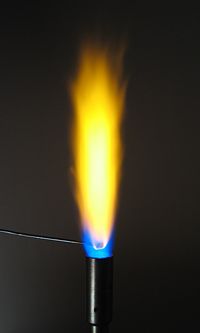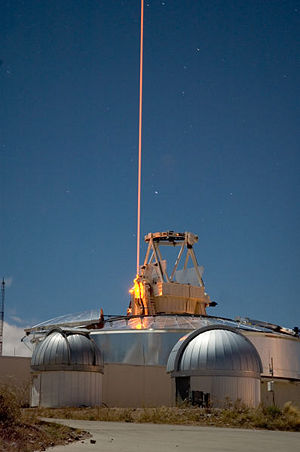Sodium
| |||||||||||||||||||||||||
| General | |||||||||||||||||||||||||
|---|---|---|---|---|---|---|---|---|---|---|---|---|---|---|---|---|---|---|---|---|---|---|---|---|---|
| Name, Symbol, Number | sodium, Na, 11 | ||||||||||||||||||||||||
| Chemical series | alkali metals | ||||||||||||||||||||||||
| Group, Period, Block | 1, 3, s | ||||||||||||||||||||||||
| Appearance | silvery white 
| ||||||||||||||||||||||||
| Atomic mass | 22.98976928(2) g/mol | ||||||||||||||||||||||||
| Electron configuration | [Ne] 3s1 | ||||||||||||||||||||||||
| Electrons per shell | 2, 8, 1 | ||||||||||||||||||||||||
| Physical properties | |||||||||||||||||||||||||
| Phase | solid | ||||||||||||||||||||||||
| Density (near r.t.) | 0.968 g/cm³ | ||||||||||||||||||||||||
| Liquid density at m.p. | 0.927 g/cm³ | ||||||||||||||||||||||||
| Melting point | 370.87 K (97.72 °C, 207.9 °F) | ||||||||||||||||||||||||
| Boiling point | 1156 K (883 °C, 1621 °F) | ||||||||||||||||||||||||
| Critical point | (extrapolated) 2573 K, 35 MPa | ||||||||||||||||||||||||
| Heat of fusion | 2.60 kJ/mol | ||||||||||||||||||||||||
| Heat of vaporization | 97.42 kJ/mol | ||||||||||||||||||||||||
| Heat capacity | (25 °C) 28.230 J/(mol·K) | ||||||||||||||||||||||||
| |||||||||||||||||||||||||
| Atomic properties | |||||||||||||||||||||||||
| Crystal structure | cubic body centered | ||||||||||||||||||||||||
| Oxidation states | 1 (strongly basic oxide) | ||||||||||||||||||||||||
| Electronegativity | 0.93 (Pauling scale) | ||||||||||||||||||||||||
| Ionization energies (more) |
1st: 495.8 kJ/mol | ||||||||||||||||||||||||
| 2nd: 4562 kJ/mol | |||||||||||||||||||||||||
| 3rd: 6910.3 kJ/mol | |||||||||||||||||||||||||
| Atomic radius | 180 pm | ||||||||||||||||||||||||
| Atomic radius (calc.) | 190 pm | ||||||||||||||||||||||||
| Covalent radius | 154 pm | ||||||||||||||||||||||||
| Van der Waals radius | 227 pm | ||||||||||||||||||||||||
| Miscellaneous | |||||||||||||||||||||||||
| Magnetic ordering | paramagnetic | ||||||||||||||||||||||||
| Electrical resistivity | (20 °C) 47.7 nΩ·m | ||||||||||||||||||||||||
| Thermal conductivity | (300 K) 142 W/(m·K) | ||||||||||||||||||||||||
| Thermal expansion | (25 °C) 71 µm/(m·K) | ||||||||||||||||||||||||
| Speed of sound (thin rod) | (20 °C) 3200 m/s | ||||||||||||||||||||||||
| Speed of sound (thin rod) | (r.t.) 10 m/s | ||||||||||||||||||||||||
| Shear modulus | 3.3 GPa | ||||||||||||||||||||||||
| Bulk modulus | 6.3 GPa | ||||||||||||||||||||||||
| Mohs hardness | 0.5 | ||||||||||||||||||||||||
| Brinell hardness | 0.69 MPa | ||||||||||||||||||||||||
| CAS registry number | 7440-23-5 | ||||||||||||||||||||||||
| Notable isotopes | |||||||||||||||||||||||||
| |||||||||||||||||||||||||
- For sodium in the diet, see Edible salt.
Sodium (chemical symbol Na, atomic number 11) is a member of a group of chemical elements known as alkali metals. Soft and waxy, it is silvery in color and highly reactive. It oxidizes rapidly in air. It reacts violently with water to produce the alkali sodium hydroxide and hydrogen gas. In nature, it is bound to other elements in the form of compounds, or it occurs as cations in solution.
The ions, alloys, and compounds of potassium have a wide range of applications. Sodium ions are essential nutrients for living organisms and are found in seawater and most soil types.
- Natrium in Latin).
- it is abundant in natural compounds (especially halite).
It is highly reactive, burns with a yellow flame, reacts violently with water and oxidizes in air necessitating storage in an inert environment.
8888888888888
[Potassium is a member of a group of chemical elements known as alkali metals. It is a soft metal and is silvery white when freshly cut, but it tarnishes rapidly on exposure to air. Less dense than water, it is the second least dense metal after lithium. It reacts violently with water to produce the alkali potassium hydroxide and hydrogen gas.]
[The ions, alloys, and compounds of potassium have a wide range of applications. Potassium ions are essential nutrients for living organisms and are found in seawater and most soil types. The hydroxide of potassium is an important industrial chemical, and the chloride, sulfate, and carbonate are used in fertilizers. Potassium nitrate is used in gunpowder, the carbonate is valuable for the manufacture of glass, and the superoxide is a source of oxygen in portable respiratory systems.]
888888888888
Isolation and etymology
Compounds of sodium have long been known. The metal itself was first isolated in 1807, when Sir Humphry Davy carried out the electrolysis of caustic soda (sodium hydroxide). Sodium was deposited on the cathode.
The name sodium comes from the English word, soda. The symbol for sodium, Na, comes from the neo-Latin name for a common sodium compound called natrium. That name in turn comes from the Greek nítron, a kind of natural salt. In medieval Europe, a compound of sodium with the Latin name sodanum was used as a headache remedy.
Occurrence and production
Sodium is the fourth most abundant element on our planet and the most abundant alkali metal. It makes up about 2.6% by weight of the Earth's crust. Naturally occurring sodium is bound to other elements in many minerals. A common mineral is halite, or rock salt, which corresponds to sodium chloride, the most common compound of sodium. Other minerals that contain sodium include albite, arfvedsonite, cryolite, glaucophane, hauyne, natron, sodalite, and soda niter.
Sodium is relatively abundant in stars. Its spectral lines, known as the sodium D lines, are among the most prominent in starlight.
At the end of the nineteenth century, sodium was chemically prepared by heating sodium carbonate with carbon to 1,100 °C. The reaction may be written as follows.
- Na2CO3 (liquid) + 2 C (solid, coke) → 2 Na (vapor) + 3 CO (gas).
Sodium is now produced commercially through the electrolysis of fused (liquefied) sodium chloride. In this process, known as the Downs process, calcium chloride is mixed with the sodium chloride to lower the melting point below 600 °C. Sodium, but not calcium, is deposited on the cathode. This method is less expensive than the earlier method of electrolyzing sodium hydroxide.
Notable characteristics
Like the other alkali metals, sodium metal is a soft, lightweight, reactive metal. Owing to its extreme reactivity, its occurrence in nature takes the form of compounds, never as the pure element. Sodium metal floats on water and reacts violently with it, releasing heat, hydrogen gas, and caustic sodium hydroxide solution.
In 1860, in their paper "Chemical Analysis by Observation of Spectra" published in the scientific journal Annalen der Physik und der Chemie, Gustav Kirchhoff and Robert Bunsen reported: "In a corner of our 60 cu.m. (cubic meter) room farthest away from the apparatus, we exploded 3 mg. (milligrams) of sodium chlorate with milk sugar, while observing the nonluminous flame before the slit. After a few minutes, the flame gradually turned yellow and showed a strong sodium line that disappeared only after 10 minutes. From the weight of the sodium salt and the volume of air in the room, we easily calculate that one part by weight of air could not contain more than 1/20 millionth weight of sodium."
Under extreme pressure, sodium departs from standard rules for changing to a liquid state. Most materials need more thermal energy to melt under pressure than they do at normal atmospheric pressure. This is because the molecules are packed closer together and have less room to move. At a pressure of 30 gigapascals (300,000 times sea level atmospheric pressure), the melting temperature of sodium begins to drop. At around 100 gigapascals, sodium will melt near room temperature.
A possible explanation for the aberrant behavior of sodium is that this element has one free electron that is pushed closer to the other 10 electrons when placed under pressure, forcing interactions that are not normally present. While under pressure, solid sodium assumes several odd crystal structures suggesting that the liquid might have unusual properties such as superconduction or superfluidity. (Gregoryanz, et al., 2005)
Isotopes
There are 13 known isotopes of sodium, of which the only stable one is 23Na. Sodium has two radioactive cosmogenic isotopes—that is, isotopes produced when high-energy cosmic rays interact with the nuclei of sodium atoms. They are 22Na, with a half-life of 2.605 years, and 24Na, with a half-life of about 15 hours.
Exposure to high levels of neutron radiation (such as from a nuclear reactor accident) converts some of the stable 23Na in human blood plasma to 24Na. By measuring the concentration of the latter isotope, the neutron radiation dosage to the victim can be computed.
Applications
Sodium in its metallic form can be used to refine some reactive metals, such as zirconium and potassium, from their compounds. This alkali metal is also a component of sodium chloride (NaCl) which is vital to life. Other uses:
- In certain alloys to improve their structure.
- In soap, in combination with fatty acids.
- To descale metal (make its surface smooth).
- To purify molten metals.
- In sodium vapor lamps, an efficient means of producing light from electricity see the picture left.
- As a heat transfer fluid in some types of nuclear reactors and inside the hollow valves of high-performance internal combustion engines.
NaCl, a compound of sodium ions and chloride ions, is an important heat transfer material.
Compounds
Sodium chloride or halite, better known as common salt, is the most common compound of sodium, but sodium occurs in many other minerals, such as amphibole, cryolite, soda niter and zeolite. Sodium compounds are important to the chemical, glass, metal, paper, petroleum, soap, and textile industries. Soap is generally a sodium salt of certain fatty acids.
The sodium compounds that are the most important to industry are common salt (NaCl), soda ash (Na2CO3), baking soda (NaHCO3), caustic soda (NaOH), Chile saltpeter (NaNO3), di- and tri-sodium phosphates, sodium thiosulfate (hypo, Na2S2O3 · 5H2O), and borax (Na2B4O7 · 10H2O).
See also sodium compounds.
Precautions
Sodium's metallic form is highly explosive in water and is a poison when uncombined with other elements. The powdered form may combust spontaneously in air or oxygen. This metal should be handled carefully at all times. Sodium must be stored either in an inert atmosphere, or under a liquid hydrocarbon such as mineral oil or kerosene.
Physiology and sodium ions
Sodium ions play a diverse and important role in many physiological processes. For example, sodium ions are necessary for the regulation of blood and body fluids, transmission of nerve impulses, heart activity, and various metabolic functions.
It is widely considered that most people consume more than is needed, in the form of sodium chloride, or table salt, and that this can have a negative effect on the health.
Some potent neurotoxins, such as batrachotoxin, increase the sodium ion permeability of the cell membranes in nerves and muscles, causing a massive and irreversible depolarization of the membranes, with potentially fatal consequences.
ReferencesISBN links support NWE through referral fees
- Los Alamos National Laboratory – Sodium
- Gregoryanz, E., et al. (2005). Melting of dense sodium. Physical Review Letters: in press.
- Rebecca J. Donatelle. Health, The Basics. 6th ed. San Francisco: Pearson Education, Inc. 2005.
See also
- Periodic table
- Category:Sodium compounds
- Category:Alkali metals
External links
Credits
New World Encyclopedia writers and editors rewrote and completed the Wikipedia article in accordance with New World Encyclopedia standards. This article abides by terms of the Creative Commons CC-by-sa 3.0 License (CC-by-sa), which may be used and disseminated with proper attribution. Credit is due under the terms of this license that can reference both the New World Encyclopedia contributors and the selfless volunteer contributors of the Wikimedia Foundation. To cite this article click here for a list of acceptable citing formats.The history of earlier contributions by wikipedians is accessible to researchers here:
The history of this article since it was imported to New World Encyclopedia:
Note: Some restrictions may apply to use of individual images which are separately licensed.


